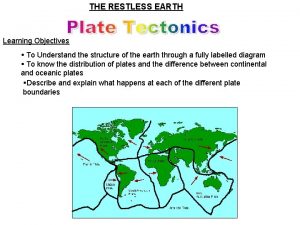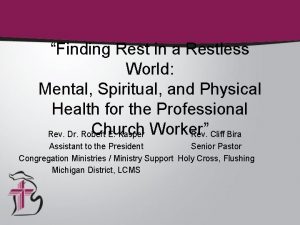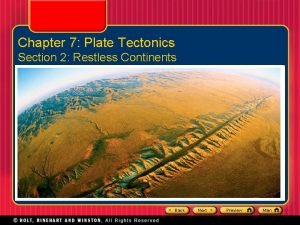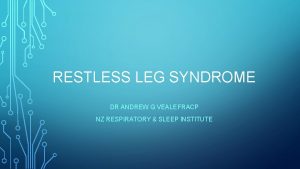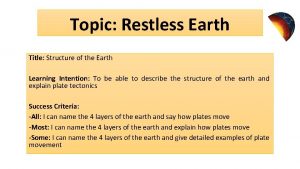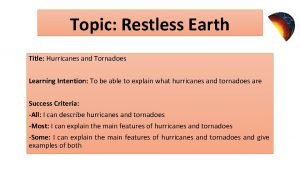Topic Restless Earth Title Living with Hazards Learning









- Slides: 9

Topic: Restless Earth Title: Living with Hazards Learning Intention: To be able to divide hazards into a range of categories Success Criteria: -All: I can name one natural and one man-made hazard -Most: I can name one natural and one man-made hazard and give examples -Some: I can further categorise natural hazards and give examples

Starter Task Unscramble the following words: 1. 2. 3. 4. 5. olfoidgn coclvina poeritun eeaauqkhrt selldina euarinrch

Starter Task - Answers 1. 2. 3. 4. 5. Flooding Volcanic eruption Earthquake Landslide Hurricane

Categorising Hazards • Natural v man-made • Natural hazards are what? • What are man-made hazards?

Definitions Copy the following definitions: • Natural hazard = result of earth’s own forces • Man-made hazard = result of human interaction with the earth

Natural Hazards Natural hazards are the result of earth’s own forces • This can include: • • • Volcanic eruptions Earthquakes Tsunamis Hurricanes Flooding Avalanches • Natural hazards can be divided into three categories: • Climatic – a result of the weather and climate • Tectonic – a result of plate tectonics (plate movement) • Slope failure – a result in the deterioration of land on an incline

Examples Natural Disaster Man-made Disaster • 2011 Japanese earthquake and tsunami • Magnitude 9 earthquake and 40 m high tsunami waves • Over 15, 000 people died and over 6000 more injured • $520 billion of damage caused • 1986 nuclear power plant disaster • Thousands of people were infected by radiation and many have now died as a result (unconfirmed numbers) • 30 km ‘exclusion zone’ in which no one can live or work (~300 people do live there as they refused to leave)

TASK Complete page 3 & 4 (first 3 questions) of the ‘Living With Hazards’ booklet. 1. Divide the hazards into natural (sub-divide into climatic, tectonic or slope failure) or man-made 2. Read the case study – ‘Aberfan, Wales’ and answer the questions on page 4. 3. Then, if you can, watch https: //www. youtube. com/watch? v=7 Hqss. T 2 Py_g

Reflections Title: Living with Hazards Learning Intention: To be able to divide hazards into a range of categories Success Criteria: -All: Can you name one natural and one man-made hazard? -Most: Can you name one natural and one man-made hazard and give examples? -Some: Can you further categorise natural hazards and give examples? https: //www. youtube. com/watch? v=ps 9 jq 6 XS 5 Sc
